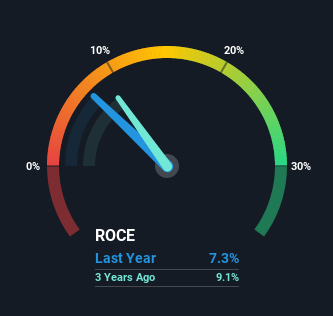Some Investors May Be Worried About Maple Leaf Foods' (TSE:MFI) Returns On Capital

What are the early trends we should look for to identify a stock that could multiply in value over the long term? Amongst other things, we'll want to see two things; firstly, a growing return on capital employed (ROCE) and secondly, an expansion in the company's amount of capital employed. If you see this, it typically means it's a company with a great business model and plenty of profitable reinvestment opportunities. In light of that, when we looked at Maple Leaf Foods (TSE:MFI) and its ROCE trend, we weren't exactly thrilled.
Understanding Return On Capital Employed (ROCE)
Just to clarify if you're unsure, ROCE is a metric for evaluating how much pre-tax income (in percentage terms) a company earns on the capital invested in its business. Analysts use this formula to calculate it for Maple Leaf Foods:
Return on Capital Employed = Earnings Before Interest and Tax (EBIT) ÷ (Total Assets - Current Liabilities)
0.073 = CA$266m ÷ (CA$4.3b - CA$665m) (Based on the trailing twelve months to September 2021).
Therefore, Maple Leaf Foods has an ROCE of 7.3%. On its own, that's a low figure but it's around the 7.7% average generated by the Food industry.
Check out our latest analysis for Maple Leaf Foods

Above you can see how the current ROCE for Maple Leaf Foods compares to its prior returns on capital, but there's only so much you can tell from the past. If you'd like, you can check out the forecasts from the analysts covering Maple Leaf Foods here for free.
What Can We Tell From Maple Leaf Foods' ROCE Trend?
On the surface, the trend of ROCE at Maple Leaf Foods doesn't inspire confidence. Over the last five years, returns on capital have decreased to 7.3% from 9.5% five years ago. Meanwhile, the business is utilizing more capital but this hasn't moved the needle much in terms of sales in the past 12 months, so this could reflect longer term investments. It's worth keeping an eye on the company's earnings from here on to see if these investments do end up contributing to the bottom line.
The Bottom Line On Maple Leaf Foods' ROCE
To conclude, we've found that Maple Leaf Foods is reinvesting in the business, but returns have been falling. And investors may be recognizing these trends since the stock has only returned a total of 11% to shareholders over the last five years. Therefore, if you're looking for a multi-bagger, we'd propose looking at other options.
Maple Leaf Foods does come with some risks though, we found 2 warning signs in our investment analysis, and 1 of those is a bit concerning...
For those who like to invest in solid companies, check out this free list of companies with solid balance sheets and high returns on equity.
New: Manage All Your Stock Portfolios in One Place
We've created the ultimate portfolio companion for stock investors, and it's free.
• Connect an unlimited number of Portfolios and see your total in one currency
• Be alerted to new Warning Signs or Risks via email or mobile
• Track the Fair Value of your stocks
Have feedback on this article? Concerned about the content? Get in touch with us directly. Alternatively, email editorial-team (at) simplywallst.com.
This article by Simply Wall St is general in nature. We provide commentary based on historical data and analyst forecasts only using an unbiased methodology and our articles are not intended to be financial advice. It does not constitute a recommendation to buy or sell any stock, and does not take account of your objectives, or your financial situation. We aim to bring you long-term focused analysis driven by fundamental data. Note that our analysis may not factor in the latest price-sensitive company announcements or qualitative material. Simply Wall St has no position in any stocks mentioned.
About TSX:MFI
Maple Leaf Foods
Produces food products in the United States, Canada, Japan, China, and internationally.
Average dividend payer and fair value.


